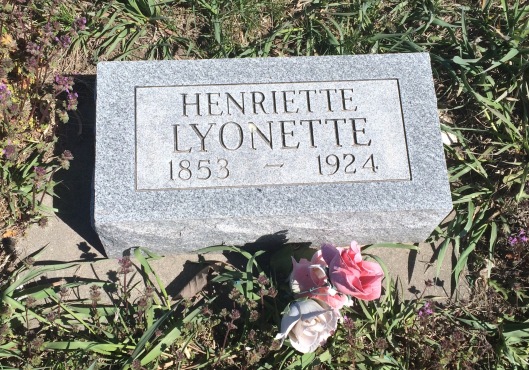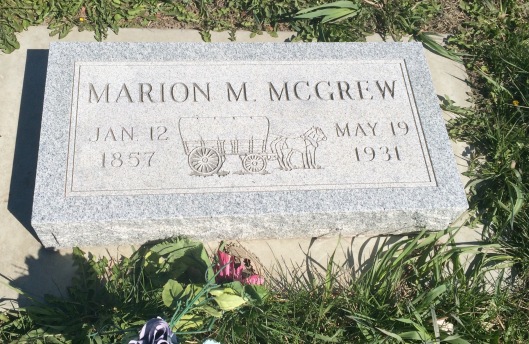I’ve wanted to write about Nebraska’s Norfolk Regional Center (NRC) cemeteries since April, but I couldn’t until now. I can now share my photos and stories because most of the NRC buildings that remained were demolished in July/August. Today I’m going to talk about the NRC’s history and one of its two cemeteries. While visiting, I discovered the graves of two women connected to famous Nebraska pioneer and storyteller, Jules Sandoz. But more about them later!

This is the Norfolk Regional Center as it looks today. This is the only occupied building left (as far as I know) and it houses a sex offender treatment center for 120 patients. Photo source: http://www.das.nebraska.gov
A few years ago, I wrote about my ancestor Levi Mercer’s burial in the cemetery of what was once the Athens Insane Asylum in Ohio. So I have a soft spot in my heart for those who are buried in nameless graves, many never marked at all.
I read about the NRC in preparation for my Nebraska Odyssey 2016 with Christi. She and I took a tour of the then still operating state mental hospital in Clarinda, Iowa a few years ago. They had a nice museum you could visit by appointment, which we did. I wasn’t a “hopper” then so I didn’t visit their cemetery.
The facility has since closed and the few patients it served were transferred to other facilities and so I think the huge building sits empty. I never forgot what I saw there. So I knew I wanted to visit the NRC if we happened to be in the Norfolk area.

Undated photo of the NRC administrative building. It was one of the last buildings to be demolished. Photo source: http://www.asylumproject.org.
The NRC opened in 1886 and I’m not entirely sure if it was called the Norfolk Insane Asylum or Norfolk State Hospital for the Insane due to conflicting information. Because of Nebraska’s increasing population, the State Lunatic Asylum (as it was called) in Lincoln had become overcrowded. The Nebraska legislature set aside $75,000 in 1885 to build a state hospital for the insane, provided Norfolk would donate 320 acres of “good land.” They did, and the first building was completed on November 1886. Below is a picture of what four of the buildings looked like at one time.

Photo of four buildings for the Norfolk State Hospital for the Insane. Photo source: Elkhorn Valley Museum and Research Center, Norfolk, Nebraska.
While some patients suffered from genuinely serious mental illness, many would not be considered mentally ill or in need of institutionalization today. In the 19th century, patients were admitted for such reasons as “domestic trouble, disappointment in love, financial trouble, hepatic dullness, heredity, intemperance, overwork, sun stroke, and others.”
One article I read reaffirmed something else I had heard about many mental institutions at that time. Historian Nancy Zaruba said, “”It was basically an old people’s home,” she said. “If families didn’t know what to do with Uncle John, that’s where they put him.”
In 1901, a fire destroyed all but one building. Only one patient died, and the rest were moved to mental institutions in Lincoln and Hastings (that facility opened in 1889 and is still in operation.) In 1905, the NRC re-opened, with three ward cottages and an administration building.

Photo of the NRC after the 1901 fire. You can see the “Nebraska Insane Asylum” sign in the center. Photo source: http://www.asylumprojects.org.
At its peak, the NRC housed more than 1,300 patients. For many years, the hospital was a self-sufficient community, with a complete farm operation. Inmates did much of the work on the farm and in the dairy, in addition to doing custodial work in the buildings. Patients and staff butchered their own meat, preserved vegetables, and produced their own clothing.

A 1914 photo of the NRC garden. Photo source: http://www.asylumproject.org.
Before 1920, patient care was almost entirely custodial with few attempts at genuine treatment of mental illness. Introduced were recreational and occupational therapy, and the hospital had a chorus and orchestra. Electroconvulsive therapy (and later insulin shock therapy), hydrotherapy and and fever therapy were implemented as well.

Patients dining at the NRC. Year is unknown. Photo source: http://www.asylumproject.org.
Beginning in early 1950s, development of psychiatric drugs opened up new avenues for rehabilitating patients and the hospital’s population began to decline. In 1962, the hospital’s name was changed to Norfolk Regional Center.
After the passage of mental health care legislation in 2004, more patients were moved from state regional centers like NRC. By 2006, there were only 100 beds remaining at the center, and its future was in doubt. But the Nebraska legislature passed a measure broadening the definition of a sex offender, and added new requirements for post-prison treatment. In mid-2006, it discharged its final mental-health patient and devoted itself exclusively to sex offenders in the remaining operating building on the NRC campus.
The NRC has two cemeteries, the New Cemetery and the Old Cemetery (which opened in 1888). Established in 1916, the New Cemetery is located on the corner of a busy intersection beside the Chuck M. Pohlman Agricultural Complex, which is part of Northeast Community College. William Osborn was the first person buried there. According to the article, the 71-year-old died in 1916 of “apoplexy.”
Because it only has a handful of grave markers, few driving by would know the large corner lot is a cemetery. In fact, we drove past it twice before we figured out that was where it was located. It’s fenced off but there were no signs saying you could not enter.
Records indicate there are around perhaps 450 patients buried in the NRC New Cemetery. I don’t know why most of the graves are unmarked or when some of the markers that are there were placed. In 2008, there were only seven there but now there are 12. I also don’t know when or who placed the benches and memorial stone in one corner.
It felt a bit lonely there but part of me is relieved that it remains a cemetery and hasn’t been paved over for a parking lot as so often happens when the deceased are poor and forgotten like these patients.

I don’t now what year the benches and sign were placed. But it felt good to know someone cared enough to memorialize these forgotten souls.
As I mentioned earlier, two women buried at NRC’s New Cemetery are connected. A native of France, Henriette Lyonette was the second of the four wives of Jules Sandoz. The Swiss immigrant was the inspiration for his daughter Mari Sandoz’ noted 1935 book Old Jules. The book documents not only prairie life in the Sandhills region of Nebraska, but also the extreme abuse and cruelty Jules showed his wives and children.

While a colorful storyteller and pioneer, Jules Sandoz was also a violent, abusive man who terrorized his wives and children over the years. “Women who won’t obey their husbands are worthless,” he said.
Although she was turned down by several publishers, Mari Sandoz’ book eventually won the Atlantic Monthly 1935 non-fiction prize. The book proved so popular (Jules was also apparently a colorful storyteller) that it inspired the Old Jules Trail, linking locations of importance to the Sandoz family history.

The second wife of Jules Sandoz, Henriette Lyonette divorced him in 1892 due to his abusiveness. Her marker looks fairly recent.
Henriette divorced Jules in 1892 because of his abuse. They had no children together. The 1900 Census shows her living alone in Rushville, Neb. and by the 1920 Census, she was living at the Norfolk Hospital for the Insane. She died there in 1924.
Elsie Raymond Sandoz was the wife of Peter Sandoz, a cousin of Jules Sandoz. She and Peter were both natives of Switzerland and married around 1905, settling in Sheridan, Neb. They had two daughters. By 1920, she was a patient at the Norfolk Hospital for the Insane. Did she and Henriette know each other from their Sandoz connection? I don’t know. Elsie did stay married to Peter until her death in 1946. He did not remarry and worked on cattle ranches until his death in 1958.

Elsie Raymond Sandoz was related to the Sandoz family by marriage. She was a patient at the NRC at the same time as Jules Sandoz’ second wife, Henriette. Did they know each other?
Interestingly, an Estella Sandoz is also listed beside Elsie on the 1920 Census for the Norfolk Hospital. Jules’s first wife was named Estella but I don’t think it’s her. Jules had encouraged many of his family members back in Switzerland to emigrate to Nebraska and they had come, settling and having families there. One of these relatives was an Estella Sandoz.
The other handful of patients who had markers I could find little information about except for Marion McGrew. He and his wife, Eva, moved from Illinois in 1881 to live on a homestead claim in Chambers, Neb., living in a sod house. The family eventually returned to Illinois in 1895. Marion was a patient at the NRC by 1910 where he remained until his death in 1931.

Marion Miles McGrew spent over three decades at the NRC. His eldest son said in an article, “The time spent in Nebraska is best forgotten. All pioneer life was hard, but it was worst there.”

A native of Virginia or West Virginia, Walter Carlyle was a divorced farmer. Because he never appears as living at the NRC on a U.S. Census, I believe he only possibly spent the last year of his life there.

Caroline Blele married her husband, Ole, in South Dakota in 1908. It was a second marriage for both. They had several children together. I don’t know how long she was a patient at NRC.
Next week, I’ll take you inside the NRC employee building shortly before it was torn down (something I should not have done). We’ll also visit the NRC Old Cemetery, which I later learned we were supposed to get permission to do ahead of time (something I didn’t know we had to do but should have done).
I hope you’ll forgive my lack of law-abidingness and join me for the trip.

































